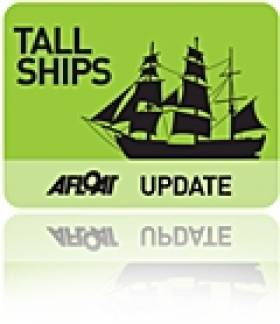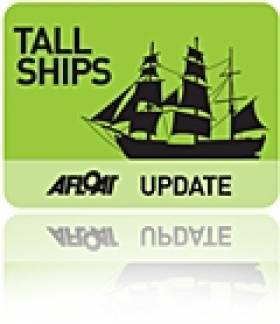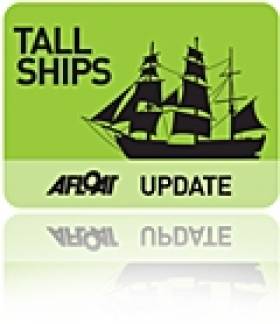Displaying items by tag: workshop
West Cork School Offers Temporary Tall Ship Sloop Solution
"There was fantastic energy at the Tall Ships workshop and while it was agreed that Ireland would benefit tremendously from an iconic square rigger tall sihip, this will take some to bring to fruition.
In the meantime, we are can look to existing Tall Ships operating with Irish Flag to offer the great experience that Sail Training can offer. Rohan MacAllister, previously captain of Asgard II for 10 years attended the meeting with Gail & Niall MacAllister of West Cork Sailing Centre to present Cypraea as a marvelous tall ship sailing sloop that is equipped to provide sail training on our Irish waters this summer.
The attendees of the meeting congratulated the MacAllisters on their tenacity and determination in bringing their sail training vessel to our waters and making the "Sail Training Experience" accessable for teenagers and adults this summer by dedicating July to Teenage Sail Training 5 day adventure sails for 350 euro and August to Adults at 450 euro.
Cypraea is a 23.5m steel sloop with berths for 10 at present and plans to increase to 16. She has three sails and is an extremely hands on team work sailing experience.
West Cork Sailing have been providing ISA and RYA sailing for many years and are excited to be providing Sail Training and the amazing life changing opportunity that it can bring".
Looking for further reading on Tall Ships in Ireland? Click the links below:
Click this link to read all our Tall Ships Stories on one handy page
Previewing Ireland's Tall Ships 2011 Season
Can Ireland Get a New Tall Ship?
Dubin's Lord Mayor opened a Tall Ship and Youth Sail Training Workshop with an agenda to seek a solution to the current Irish Sail Training impasse caused by the loss of sailing's Asgard II and Lord Rank.
Over 70 delegtes including many of the 'top brass' of the Irish Tall Ship commuunity attended the meeting held at the offices of Dublin Port Company on Saturday (26th March). The meeting inlcuded members of Coiste an Asgard, port companies, education, tourism and other sailing interests.
The meeting was formally opened by Dublin Lord Mayor and Port Admiral, Gerry Breen who introduced the chairman Lord Glentoran and the Facilitator Michael Counahan.

From (Left to right) Seamus McLoughlin, Dublin Port Head of Operations, Enda Connellan, Chairman Tall Ships Dublin 2012, Des Whelan, Chair Tall Ships Waterford 2011, Lord Glentoran (Robin Dixon) Chair Tall Ships Belfast 1992, Dr. Gerard O'Hare, Chair Tall Ships Belfast 2009, Ted Crosbie, Tall Ships Cork and Enda O'Coineen, LetsdoitGlobal.
Des Whelan gave an excellent talk and presentation on Tall Ships Waterford which was followed by a discussion on the massive economic benefits of bringing Tall Ships Festivals To Dublin, Cork and Belfast. Chairman of Tall Ships Dublin 2012 Enda Connellan and Ted Crosbie of Tall Ships Cork and Dr. Gerard O' Hare of Tall Ships Belfast discussed the incredible success stories from their respective ports festivals.
Several presentations and discussions followed regarding the role of Tall Ships in Sail Training, the connection between a vessel for Ireland and running events here. The question of who are the stakeholders and how can benefits be quantified was also discussed.
The meeting was hosted by Dublin Port Company who provided a warm welcome, excellent facilities, refreshments and a wonderful lunch with senior management attending to everyone's needs.
After lunch there were further discussions on what is the most suitable vessel, who should run the organisation and what would work best for Ireland.
Jimmy Tyrrell gave a short, eloquent and emotional account of Asgard II and the realisation of his father's dream which was fulfilled beyond all expectation by that legendary vessel and those who were privileged to sail on her. He affirmed his own belief that the way forward was with an All-Ireland Tall Ship and even suggested that she be called Spirit of Ireland. There were other suggestions for a name inlcuding 'Ireland's Call'.
A view was also expressed that politics and religion have no place in Sail Trail Training and the future lay in an All-Ireland Commercial/Charitable Trust Venture.
The prohibitive nature of current legislation and the total lack of awareness of the maritime sector by the Government was mentioned several times.
Ocean Youth Club NI provided four young sail trainees to address the gathering on the benefits of Sail Training from their perspective and representatives from education, tourism Tall Ships International and "Association Of Tall Ships Organisations" also contributed.
The general consensus was the need to develop and promote, as a matter of urgency, a plan for a Tall Ship For Ireland linking Youth, Maritime Education, Business and Tourism.
Another workshop will be held in Belfast in April and the collective input of both meetings will be considered going forward.
A Tall Order for Ireland? HERE
Regular updates on Irish Tall Ship sailing news HERE
More on Asgard II HERE
Tall Order for Ireland
Sailing in Ireland could yet have a tall ship to replace the Asgard II and the Lord Rank. A meeting in Dublin in late March represents a major step forward in the process to put an Irish tall ship back on the high seas.
The open workshop, to be held on March 26th, will be facilitated by Dublin Port, and will include state interests, tourism interests, commercial port interests, youth organisations, maritime organisations and education groups, together with the former Lord Rank and Asgard II operators.
The catalyst for the initiative is a 'reference group' which represents a broad cross-section of interests, both North and South. Operating under the chairmanship of Lord Glentoran, and supported by Dr Gerard O'Hare, David Beattie and Enda O'Coineen, the group has also engaged a professional consulting firm to move the process along.
The initial focus is on the necessary organisation and rationale behind building a new vessel, while scientifically quantifying the benefits to build a plan and justification.
The view taken is that, while there may be no money available at this time, there is no excuse for not having a plan and the idea is to create ' joined-up' thinking. And while the government in the South placed the insurance money paid out on Asgard II back into general exchequer funds, the insurance payment on the Lord Rank was kept and ' ring-fenced' for this new initiative.
To date, there have been several meetings of the reference group. The planned workshop on the subject at Dublin Port March 26 is open and interested parties are invited to contribute. It will also bring together for the first time the leaders of Tallships in Dublin, Belfast, Waterford and Cork.
Ultimately Tall Ships is about youth training and development; without an active Tall Ship, it will be very difficult for Ireland to attract Tall Ship events. The new reference group will work to support the new Sail Training Ireland Association initiative, and link in with Sail Training International which runs Tall Ship events.
Following the Dublin workshop, Belfast Harbour Commissioners will host a working meeting of the group in early May to finalise a plan, present to stakeholders and create a roadmap forward.
"In addition to youth training, a working Tall Ship forms a brilliant ambassadorial role promoting tourism, enterprise and commercial interests," said Lord Glentoran. "It is something that we can all relate to and it has universal acceptance for youth training on an island of Ireland basis." Lord Glentoran has a long commitment to youth sail training and was Chairman of the organising committee that brought the Tall Ships to Belfast in 1991.
The reference group is seeking to engage with as many stakeholders as possible, and has pledged that the new vessel will be owned by the community in Ireland and the Irish Diaspora. The initial view is that the project clearly needs to be linked with the institutions of State - North and South - as are universities state agencies and ports, while at the same time having a strong private support network making for a mix of public and private funding, "We now have a brilliant opportunity to look around the world, establish best practice in the best kind of vessel, how to fund it and to quantify the benefits for each of the stakeholder group," said Enda O'Coineen, who has been instrumental in bringing the group together. In addition to being a former Coiste and Asgard Director, he is the founding Chairman of Let's Do It Global, which brought the Volvo Ocean Race to Galway and successfully raced the Green Dragon around the world.
O'Coineen added that a "world class solution" can be created and that its benefits can be financially quantified, which would allow supporters to make a compelling business case to divert and use existing funds in Tourism, Enterprise and Youth Training. "While there is no money available now to support the scale and professionalism needed, this is not an excuse not to have a plan and a vision," he added.
Since the loss of the Asgard II and Lord Rank, Ireland has been left with no sail training opportunities for young people and likewise for maritime development, enterprise and tourism. If nothing is done, future generations will suffer. The reference group believes that the solution is the construction of an Ireland - North and South - training vessel, fulfilling several roles with a common mission and resourced according to quantifiable benefits delivered to stakeholders. It is also open to the use of an existing vessel - a key component being suitability and the operations budget.
The proposed Tall Ship project will enhance skills and opportunities for young people across the island, regardless of background, class or education. It could be used to showcase Ireland as a brand at overseas events and it could also host international students who wish to come to the island of Ireland, as is the case with many of the International Tall Ships Programmes already running on a global scale which create a huge amount of tourism for their respective countries.
The reference group notes that the Tall Ships concept appeals to young and old alike as the romanticism behind the concept touches on history, social studies, legacy, family, travel, adventure and, most importantly, fun. Tall Ships allow people to dream. They do however have an underlying seriousness and the concept is grounded in methodology that has been tested and proven the world over.
An advertisement in March/April of Afloat magazine - out now - gives full detials of the 'Tall Ship for Ireland' Workshop
Should Ireland be represented at the Tall Ships Races at Waterford 2011 and Dublin 2012? We want your vote on our Facebook Poll HERE.
Looking for further reading on Tall Ships in Ireland? Click the links below:
Click this link to read all our Tall Ships Stories on one handy page
Previewing Ireland's Tall Ships 2011 Season
Stakeholders Discuss Measures to Protect Celtic Sea
Stakeholders from France, England, Ireland and Wales attended a two-day workshop in Cork last week with a view to establishing a new code to protect the natural environment of the Celtic Sea from the effects of marine activities, World Fishing reports.
The workshop was hosted by Pisces, a marine project funded by EC LIFE+ that aims to develop holistic guidelines promoting a healthy marine environment in harmony with marine activities such as fishing and shipping, aquatic tourism and offshore infrastructure.
Roger Cook of the Welsh Federation of Sea Anglers said: "It’s great to be here with stakeholders who have a lot of information and knowledge of what’s going on, and we’re all coming here to share the objective that there are real advantages to us all if we can get this ecosystem based management thing right.”
The workshop was the first step in a process that will see consultations with various interested sectors before the final guidelines are published in 2012, fulfilling requirements of the European Union's Marine Strategy Framework Directive which requires member states to achieve or maintain 'good environmental status' by 2020.
Wicklow Boatyard at the Cutting Edge
Afloat magazine profiles Noonan Boats, one of the country’s leading repair facilities
From collision damage, keel fairing right up to osmosis treatments and re-sprays, Noonan boatyard in Newcastle, Greystones Co. Wicklow offers such a comprehensive service on the East Coast there is little need for any boat to go abroad for repairs these days, regardless of the extent of damage.
And news of the quality work has been spreading with boats from the four coasts Ireland coming to Wicklow for a range of work.
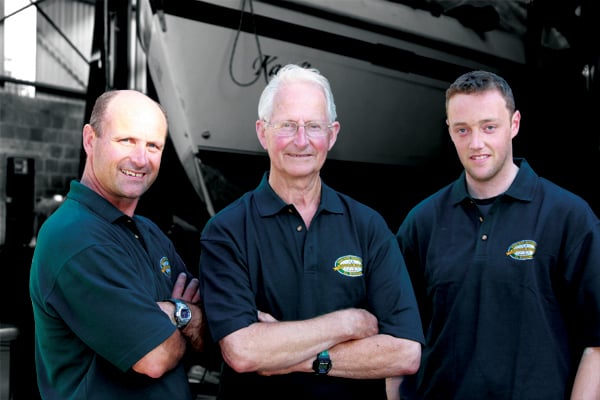
Graeme Noonan (left) has extensive big boat repair experience from his time in the marine industry in Sydney, Australia and is an active RS sailor. Founder Tony Noonan (centre) has spent a lifetime in the Irish Marine industry with Neil Watson Yachts, Wicklow Marine Services before setting up Noonan Boats in 1995. Brian Flahive is an active dinghy and keelboat sailor this year finished second in the Round Ireland double-handed class and won the Fireball National Championships.
Father and son team Tony and Graeme Noonan have over 30 years in the business and have recently expanded the premises to over 3,000 sq feet to cater for a growing range of repair work for boats up to 50 feet under cover.
They have a well-established reputation for the treatment of osmosis, to resolve hull blistering. This is a preventative and remedial process that requires specialist treatment.
The bulk of repair work comes from along the East Coast based boats and the nearby port of Dun Laoghaire but the company offers a national service to include transport to and from the Noonan boatyard if required.
“We have an established track record dealing with Insurance companies. No job is too difficult, too small or too big for us” says Tony Noonan.
Most work is carried out in in a purpose-built marine workshop containing two lifting bay facilities that includes keel and rudder repair pits but the firm also carries out on site repairs to suit too.
Repairs are carried out to original specifications and they carry out re-moulding repairs to up to date construction methods e.g. GRP foam core, Balsa core and carbon under vacuum bagging conditions.
A particular speciality is the repair of carbon repairs to dinghy masts, spinnaker poles and hulls. This has become more popular recently with the advent of carbon bowsprits on boats such as the J109s and SB3s.
Keel fairing, the process of improving the accuracy of the shape of a keel to improve boat speed is also high on the jobs list.
The company also has the specialist hot weld equipment to carry out the repair of polyethylene materials as used in the RS Feva and Laser Pico dinghies.
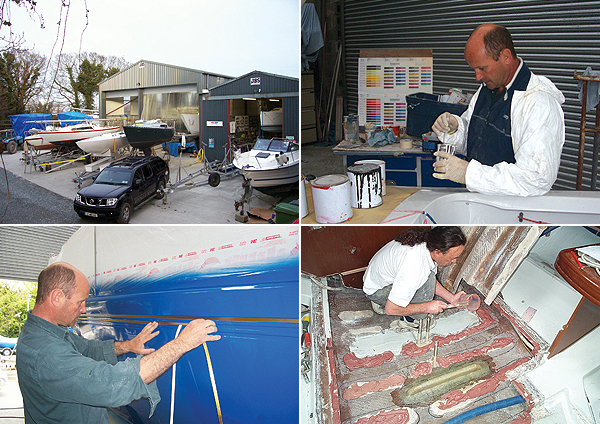
Colour Matching
Making a fibreglass repair to bring a boat back to original specification is one thing but matching gel coat to weathered or faded paintwork is quite another. Noonan Boatyard cosmetically match gels to present colour so the repair can appear practically invisible.
Polyethelene Repair
Plastic boats are durable but they can split and crack. Repairing them requires specialist heat gun welding equipment
Repair and re-spray
Weathered topsides, especially darker colours, always benefit from a re-spray, tired areas including decks and non-skid areas can also be re-sprayed
Floor matrix repair
After a keel grounding with rocks, for example, damage to a floor matrix may not be immediately visible but it is vital that inner frames are checked and repaired
Osmosis treatment, hot vac and copper coat
The yard uses the latest technology in the treatment of osmosis. Hulls are gel-planed to expose lay up prior to a HOT- VAC process and drying. This can be the stage where copper coat is an economical choice. It ends the need for the expensive and unpleasant annual chore of cleaning and repainting a boat’s hull. Simply hose down the hull at regular intervals, commonly once a year, to remove any build-up of sea-slime. We currently have two examples in our yard at present which show after one year and after ten years of immersion – and still working. Come and see for yourself!
Fully Repaired, Tried and Tested
Noonan Boats completed extensive repairs to Oystercatcher, a Gibsea 37, and when this work was completed the firm entered the boat in the gruelling 704-mile race round Ireland.
Local sailors Brian Flahive (Fireball National Champion) who works at the yard and Bryan Byrne manned what was Wicklow Sailing Club’s first ever yacht to entry into the doubled handed class of the Race. Dubbed the ‘Pride of Newcastle’ the entry finished an impressive winner of IRC III and Cruiser Class IV. The pair also finished second in the two handed class.
It was no easy journey but certainly the repairs stood up to the job, a case of repair work being tried, tested and proven!
The Boatyard, Sea Road, Newcastle, Greystones, Co. Wicklow
Tel/Fax: 01 281 9175 • Mobile: 086 170 8875
Email: [email protected]
- boats
- Wicklow
- RS Feva
- Dun Laoghaire
- Greystones
- collision
- Brian Flahive
- noonans boats
- wicklow boatyard
- boat repair
- keel fairing
- osmosis
- Newcastle
- Neil Watson
- Graeme Noonan
- Tony Noonan
- repair
- hull blistering
- Insurance
- lifting bay
- workshop
- GRP
- vacuum bagging
- carbon repairs
- dinghy masts
- spinnaker poles
- Laser Pico
- Polyethelene Repair
- respray
- Floor matrix
- hot vac
- copper coat
- Repaired
- damage




























